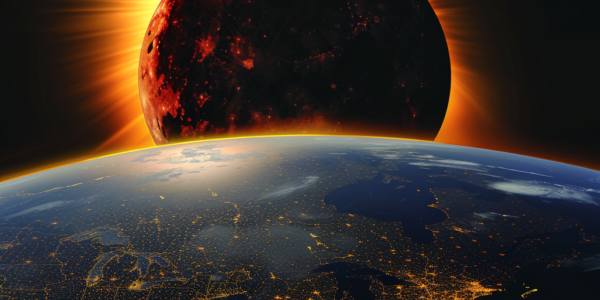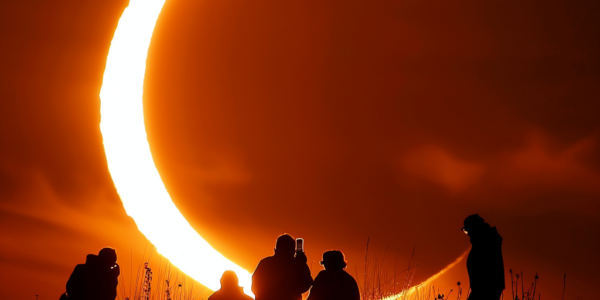How to Safely View the Eclipse with Legitimate Solar Eclipse Glasses
As eclipse day approaches, make sure to have legitimate solar eclipse glasses to protect your eyes from permanent damage. Legitimate glasses should be marked with the ISO certification number ISO 12312-2 and registered as a ‘Solar Viewer Brand’ with the American Astronomical Society. Test your glasses ahead of time and inspect them for scratches and tears. Do not use ordinary sunglasses as they do not provide adequate protection. Check out local stores and museums for safe eclipse glasses.
Raising Cane’s Plans Special Offer for Rare Total Eclipse Event
Raising Cane’s is gearing up for the rare total eclipse on April 8, 2024, with a special offer for its customers. With over 190 restaurants located along the eclipse trajectory, customers can enjoy a free Texas toast with every Combo purchased on the day of the eclipse. Plus, one lucky customer will have the chance to win ‘Free Cane’s for 20 Years’ in a draw. Don’t miss this celestial celebration – mark your calendars for April 8 and head to your nearest Raising Cane’s!
Astrologer Suggests Astrological Causes for Recent Earthquake in New York City and New Jersey
Astrologer Kyle Thomas discusses the potential astrological causes behind the recent earthquake in New York City and New Jersey, attributing it to the positioning of Uranus in Taurus. He highlights the upcoming Jupiter-Uranus conjunction in 2024 and advises individuals to stay informed about the potential impacts of these astrological phenomena.
Enthusiasts Prepare for 2024 Total Solar Eclipse with Safe Viewing Glasses
Prepare for the 2024 total solar eclipse by securing safe viewing glasses from reputable retailers. Ensure the glasses are certified by the International Organization for Standardization (ISO) to avoid counterfeit products. Stay vigilant against fake eclipse glasses and conduct pre-eclipse testing to confirm their effectiveness. Residents of Texas have a prime opportunity to experience the eclipse in its full splendor, so secure legitimate solar eclipse glasses for a memorable and safe viewing experience.
Eclipse Glasses Mislabeled and Should NOT Be Used to View Eclipse
Biniki brand eclipse glasses mislabeled and should not be used to view the upcoming eclipse on April 8. UK Libraries ask that these glasses be discarded immediately and not used for viewing the eclipse. Reliable vendors for eclipse glasses include Rainbow Symphony, American Paper Optics, and others recommended by the American Astronomical Society (AAS).
Rare Total Solar Eclipse to Cross North America on Monday
A total solar eclipse is set to cross North America on Monday, offering a rare spectacle as the moon blocks the face of the sun, temporarily darkening afternoon skies. The eclipse’s path will span Mexico, 15 U.S. states, and a small part of eastern Canada, providing a unique viewing opportunity for millions. For those outside the direct path, a partial solar eclipse will still be visible, with the moon appearing to take a ‘bite’ out of the sun and partially obscuring its light. Solar eclipses occur when the sun, moon, and Earth align, causing the moon to pass between the Earth and the sun, blocking its light and casting a shadow on the Earth. Neil deGrasse Tyson, director of the Hayden Planetarium at the American Museum of Natural History, explained that solar eclipses occur only with the new moon due to the tilted orbit of the moon around the Earth. This year’s eclipse will be visible over more populated areas of the continental U.S. than previous total solar eclipses, providing an opportunity for a wider audience to witness the celestial event.
Debunking Eclipse Myths and Health Concerns
Learn about the real health risks of solar eclipses and the myths surrounding their impact on pregnancy. Find out how to protect your eyes and your baby’s health during an eclipse.
Last-Minute Guide to the Total Solar Eclipse Crossing North America
A total solar eclipse is set to cross North America on Monday, providing a rare opportunity for millions to witness the afternoon skies darken as the moon blocks the sun. Here’s your last-minute guide to this rare celestial event. Learn what a solar eclipse is, where and when it will be visible, how to view it safely, and fun milestones to look out for. Don’t miss this extraordinary celestial event on Monday!
How to Wear Solar Eclipse Glasses
Learn how and when to wear solar eclipse glasses to safely view the solar eclipse on April 8, 2024. Find out the dos and don’ts from experts to ensure you don’t miss out on this once-in-a-lifetime opportunity.
KASI to Conduct Ground Observations of CODEX During Total Solar Eclipse
South Korea’s space institute, KASI, plans to conduct ground observations of the Coronal Diagnostic Experiment (CODEX) during the total solar eclipse on April 8th in collaboration with NASA. This presents a unique opportunity to study the Sun’s corona, normally obscured by bright sunlight. KASI will dispatch teams to Texas to utilize polarizing cameras and a new polarimetric instrument, marking a significant advancement in solar science.










